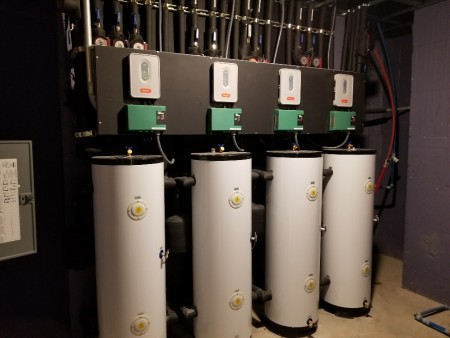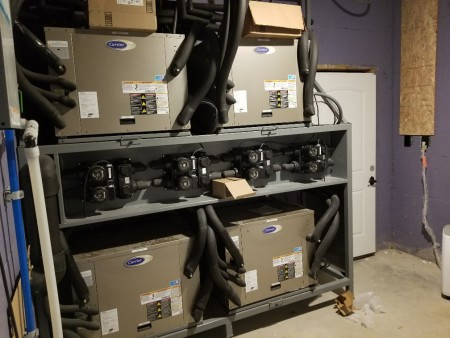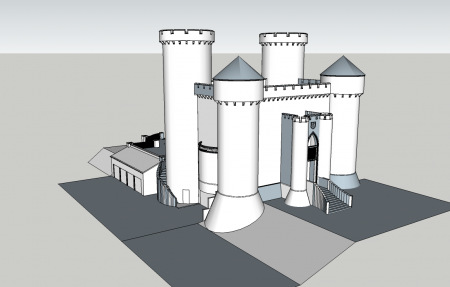This has been a long process, when I say years ago, I really do mean years ago. Also writing this post was a long process, I wrote it over a period of months.
So, years ago, when we were designing this place it wasn’t simply a matter of drawing walls on paper, engineering must be done, structural, mechanical, electrical, it was all very complex. The finished plans weighed probably 30 or 40 pounds when printed. Imagine all those dead trees.
I had done my own research on how to heat and cool this place and it seemed to me ductless minisplit systems would be the way to go. Many of the design choices I’ve made in his home come from my dissatisfaction with conditions in other homes where I have lived. For instance, I hated how you would have but one thermostat in a home and so some rooms would be hot and some cold (and usually it was my bedroom that was the wrong temperature). Also I intrinsically knew that if I had a HVAC system in the basement and it was trying to blow air up to the 4th floor we’d have a problem. I needed a distributed system.
So I first really got into this Mitsuibishi system called City Multi. It was a ductless (meaning refrigerant was pumped around the house in little pipes, not big ducts), and split, which meant that the heat pump and the air handler were separated from each other. The heat pump (condenser would be a similar word) is what makes air (or refrigerant, or water) hot or cold, and the air handler is what blows it around. This system could have many different zones throughout the home with independent thermostats and could even move hot air from one room to another without using much energy, making it very efficient.
There are two types of heat pumps we could use with this system, air source or ground (sometimes called water) source. Air source heat pumps work by pulling heat (or lack there of) from the surrounding air outside your home. So when its 90 degrees out and your air conditioning is on its trying to pull cold air out of that 90 degree heat, and in winter when it is 32 degrees out it is trying to pull heat out of that 32 degree air. This is hard to do and takes a lot of energy making air source heat pumps less efficient.
Ground or water source heat pumps work with water, and if you remember from school water is a much better conductor of heat than air, which is why an ice cube melts faster in cold running water than in a hot oven. Additionally if you get your water from underground, such as through a geothermal well loop, it is always 55 degrees. So in winter, when it is 32 degrees out, your heat pump can make heat from 55 degree water instead of 32 degree air, and in summer, when it is 90 degrees out, your heat pump can make coolness from 55 degree water instead of 90 degree air. It takes far less energy.
Of course, it is expensive to put in a geothermal ground loop, though you do earn back your investment, the upfront cost keeps many people from doing it. A nice side effect though is you can enjoy the outdoors without hearing the whirring fan of your heat pump, only birds and leaves rustling.
So we did the geothermal ground loop, quite a few years ago, and hooked it all up late last year, but I’m getting ahead of myself.
The problem now with Mitsuibishi was that they required 3 phase power for their water source heat pumps, we do not have 3 phase power available at the castle, so they were out. Luckily LG had a single phase option, so rather than one big heat pump we would get 4 small single phase ones, hooked up to 14 internal air handlers (concealed in the ceilings) with 14 zones and 14 thermostats throughout the castle, with the ability to move heat between rooms if needed, variable flow, really good and efficient.
So my architects hired a mechanical engineer, Kelso Regen out of Knoxville and they designed this system and called for 20+ tons of heating and cooling capacity, like a whole lot. This was crazy, I was researching other castles, other ICF concrete homes, and none needed anywhere near that amount. The mechanical engineers apparently had little experience working with ICF homes. Anecdotally, even before we had the roof on and insulated, before we had doors and windows, you could enter the castle at the height of the summer and be cool because of the large thermal mass of the walls. Essentially for the sun to infiltrate my walls it needs to heat up two inches of stone, then two inches of foam, then up to 14 inches of concrete, then another two inches of foam, and then depending on the floor, another two inches of stone, or maybe drywall, or maybe wood paneling. Then the heat can finally get inside.
So I hired a separate firm specializing in energy efficient homes to do the analysis and they came up with a much lower tonnage, 16, which I still sorta think is too high, but we will find out. They really think I have more of a heating load than a cooling load which is weird for this area, but they worry I will lose a lot of heat out of my skylight. That also concerns me but I also have the opportunity to produce a lot of heat with my fireplaces (3 woodstoves and a masonry heater). I might have to simply weatherize my skylight in the winter, which would be doable.
I also had problems with the mechanical engineers doing things wrong or exactly the opposite of what I asked for, multiple times. For instance they put in a hot water circulation system, when I had repeatedly told them not to, because all the research shows them to be energy (money) wasters unless you live in a desert with water restrictions. They told me that they were required by code, which was of course false, they were misreading the code books – which as professionals should not have happened, was this their first house?
So we end up with this 14 zone minisplit system powered by ground source heat pumps. This other company, Rheaco Services, whom I must strongly recommend against anyone ever hiring, was contacted by the architects to do a bid for our budget. They did this, and sent us a bill for $3000 some. I’m not in the habit of paying for bids, I said they could get the money when they got the job and were actually hired to do it. But eventually, at the urging of my architect, I paid this bill. Then when it came time to have Rheaco out to do the work, guess what? They said no. So I paid them $3000 some for nothing. I’ve strongly considered taking them to court over that nonsense. So we were stuck trying to find a replacement bid with no time and most of the people had us over a barrel and were giving us just huge bids, bids that could vary by more than $100,000 dollars. By 50%. How can you get two companies in the same industry bid the same job and be apart by over $100,000 and more than 50%, nearly 100%? Because I’m convinced there are a lot of crooks, or just shady people who will bid a job not what it costs but what they think you can pay.
So we find a guy who can do it and it’ll be more, more than $50,000 more than be budgeted, but they say they can do it… only later they start getting what I could only describe as cold feet, and then the LG people come out and the LG people start telling us they don’t really recommend their product. When the manufacturer tells you their own equipment isn’t good, that was the last straw and we abandoned this system.
So then we needed to find a replacement that utilized our existing geothermal wells (and now turn out to have a leak just discovered late last week, the hits just keep on coming), and didn’t need a lot of ductwork because our walls were up at this point and we didn’t have space for big duct runs.
So eventually we settled on SpacePak, which is a high velocity system that utilizes only small 3 inch ducts that can be snaked through walls and ceilings. So we brought our engineer (the bad one) back out and walked him through and pointed out where we thought we could put their air handlers and we reduced the zones from 14 to 7 because these air handlers were larger and he said he would redo some drawings and send them to SpacePak, and what did he do? He just sent them our old plans instead, and so we lost another month or two as SpacePak did this system with 14 air handlers instead of 7.

So after more wait and more delays we finally ended up with this system whereby hidden throughout the home are 7 air handlers that turn hot or cold water into hot or cold air and shoot it with a high velocity fan through small ducts to nearby rooms. Each air handler has it’s own return air and filter. Then in the basement we have this amazingly expensive and complex room with 4 geothermal water to water heat pumps and expansion thanks. So the heat pumps take the 55 degree water from the earth and turns it into either hot or cold water which is then pumped to the 7 air handlers (on demand) and turned into hot or cold air.

We ultimately went with a very good and professional company, Air Comfort, to do the HVAC install, and we are now living in the house and it is working fine. Electricity wise, I had one partial bill that was in the high $300s, but my solar panels also weren’t turned on yet and workers and kids have been leaving a lot of lights on, and it has been in the 90s with super high humidity. The house I’m leaving my electric bills were high 200s into low 300s during such hot times so now that I’m 6x larger only going slightly more seems like a win. I think once the indoor humidity gets under control we will be able to achieve lower bills, plus the solar contribution. For instance I’m typically very comfortable with bedroom temperatures of 74 and living area temperatures of 76, but I’ve needed everything 2-3 degrees cooler in here because of the humidity. I guess all the building materials are still drying out, granted we’ve been enclosed for a year so the paint should be dry all that stone mortar and drywall and paint and stain continues to dry out. I read that some homes really don’t get down to stable humidity for a year.
Heat has been another matter, it has been very cold here in Tennessee this winter and I’ve had one bill as high as $780, other bills in the $550 range. We have a hot tub too of course and the cover kept blowing off of it. There have been issues with my heat pumps, the operating temperature was turned down which I believe lowered the efficiency. I’ve also been burning a lot of wood trying to help the heating system work. All told I’m not happy with my heat performance and efficiency. We’ve been finding gaps in insulation or weather stripping here or there. Statistically speaking when you consider how many square feet I’m conditioning I am doing better than prior homes I’ve lived in I think (slightly, perhaps), but I think I should be doing better still considering all the money put into insulation and efficient products. Solar panels are on now but with cloudy short winter days… well in December they contributed $14 dollars. Payback will be about a thousand years on those at this rate but I imagine they will do better in summer.
So I am going to keep fighting on this, figuring out how to better insulate my doors, tracking down areas of air infiltration, and hoping to get my heating system running in its most efficient manner. On the plus side I get exercise chopping wood and find it enjoyable.
I don’t know yet how to say if our 16 tons is really what we’ve ended up needing. The system has no trouble keeping the house warm, and no trouble keeping the house cool. Sometimes I feel it short cycles, especially the heat in my bedroom, but that is because a vent is over the thermostat I think. The electrical cost is more than I would like, but I don’t think the system struggles to keep up with demand. Maybe we could have used fewer tons.
